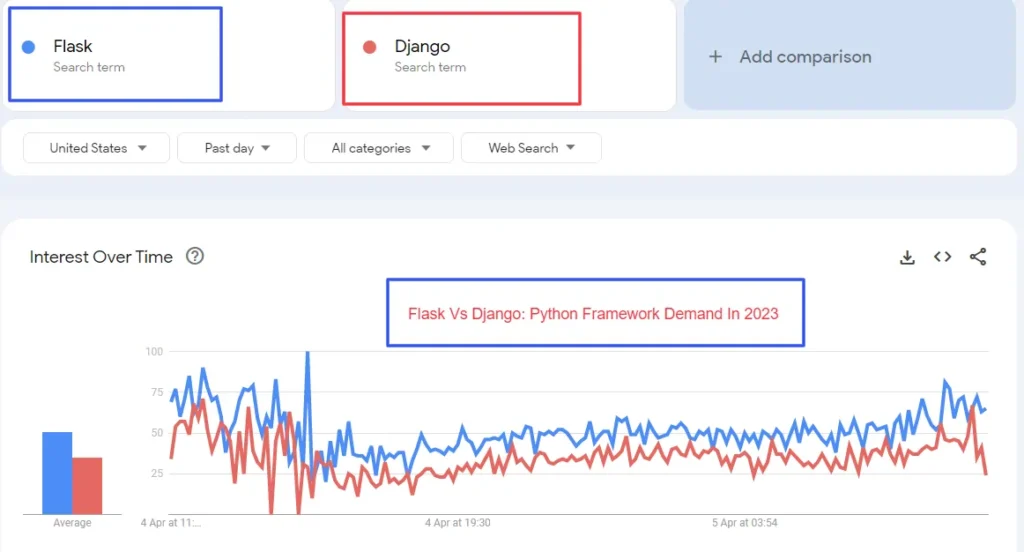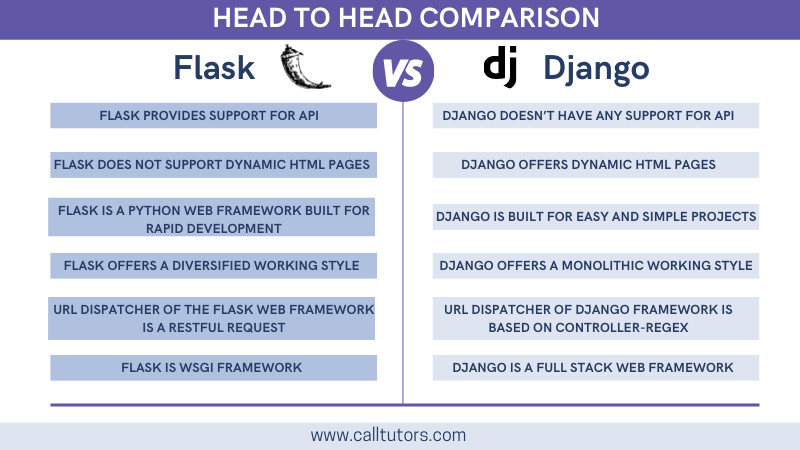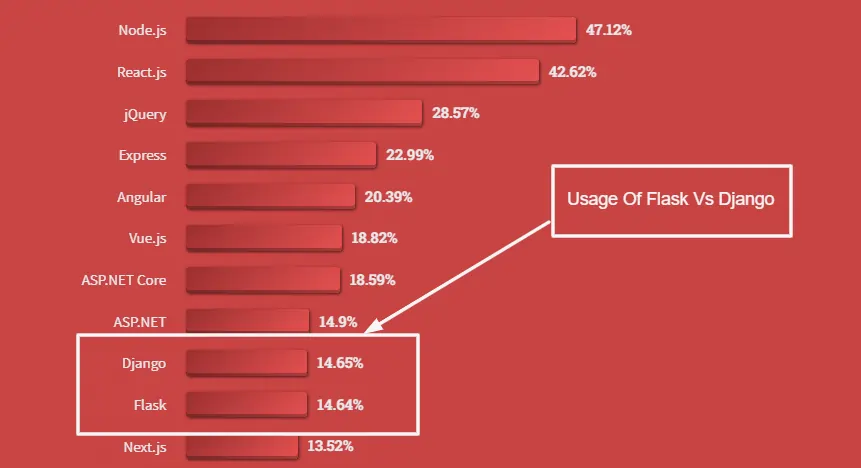Do you want to know the comparison between Flask Vs Django and which is a better framework for web development? If yes, many Python-based web frameworks make it easy for developers to create scalable apps quickly. These frameworks can handle everything from simple to complex websites.
Django vs Flask is the most talked-about of the numerous popular options, and for good reason: they are similar in some ways and different in others! This leads to a comparison of the two, and while each of these web development frameworks has its own set of characteristics, there are a number of things to consider before selecting one for your apps.
If you would like to develop web apps, then you can use Flask and Django. Both are the best Python framework. But both frameworks have various differences. If you are also confused about which language is actually used to develop the app and want to know the comparison between Flask vs Django. Also,
- What does each framework do?
- why are they so popular
- How each framework works
- Why do developers choose one over the other?
Don’t worry, here we are giving you clear-cut and in-depth information about Flask and Django.
What is Flask?
Table of Contents
Flask is a lightweight framework that is commonly referred to as a micro framework. Flask has several basic features and lets developers add as many libraries or plugins as they like to an extension. Flask should be your first pick if you have a simple, innovative use case that needs to be added to an existing application. Flask comes with a small collection of easy-to-learn APIs and comprehensive documentation. Start your web development with Flask if you’re new to Python. So you can acquire a feel for both the backend and frontend and grasp the essential ideas.
What Are The Features of Flask?
Here are some features of Flask:
- Given you (the developer) complete control over how the program is built during the development (implementation) stage.
- It has a built-in development server as well as a quick debugger.
- neat API and Coherent
- Configurations that are simple and adaptable
- RESTful and HTTP requests handling
- Support for integrated unit testing
- Werkzeug and jinja2 are Flask’s two key dependencies, providing powerful WSGI support and templates, respectively.
What Is The Advantage of a Flask?
Here are some advantages of Flask:
- It has higher compatibility with the latest technologies
- Technical experimentation
- It is easy to use for the simple case
- The codebase size is relatively smaller.
- For simple applications, scalability is high
- Routing URLs is simple.
- Applications that are simple to create and maintain
- It is simple to integrate a database.
- The core is small and easily extensible.
- Minimal yet powerful platform
- There are numerous resources available online, especially on GitHub.
What Are The Disadvantages of Flask?
Here are some disadvantages of Flask:
- In most cases, MVP development is slower.
- More complicated systems have higher maintenance expenses.
- Larger implementations require more complicated maintenance.
- Async could be a little problem.
- Lack of database and ORM
- Setting up a large project necessitates considerable familiarity with the framework.
- When compared to Django, it provides minimal support and has a smaller community.
What is Django?
Django is a web application framework that handles many standard features needed to create secure and maintained websites. All you have to do as a developer is build your business logic. Django is a free and open-source programming language with a thriving community and extensive documentation. The name Django was given to the project in July 2005. The majority of things come ‘out-of-the-box with Django as a single product. As a result, there are no concerns with integration.
What Are The Features of Django?
Here are some features of Django:
- It’s a flexible framework that can be used to build any website (social network, news site, content management system, and so on) with the content in HTML, XML, JSON, and other formats. It can be used in tandem with any client-side framework.
- It’s a safe framework that takes care of things like user account management, transaction management, cross-site request forgery, clickjacking, and other security concerns.
- It’s scalable and easy to maintain. To reuse and maintain the code, Django follows design patterns and principles. There are no duplications because the basic principle of ‘don’t repeat yourself’ is followed. Because Django is a component-based framework, each layer is self-contained, allowing the application to scale at any level.
- Django is a lightweight programming language. It’s written in python, which is now the most popular cross-platform programming language.
What Are The Advantages of Django?
Here are some advantages of Django:
- Django is simple to set up and use.
- It provides a user-friendly interface for a variety of administrative tasks.
- It has a built-in internationalization system that allows it to provide multilingual websites.
- End-to-end application testing is possible with Django.
- Allows you to create an HTML output to document your API.
- Several authentication protocols are well supported by the REST framework.
- It’s used to limit the number of API calls from a single user.
- Allow you to set patterns for your application’s URLs.
- It comes with a built-in authentication system.
- Multiple caching techniques are included in the cache framework.
- Framework for quick web development at a high level.
What Are The Disadvantages of Django?
Here are some disadvantages of Django:
- It’s a monolithic platform.
- Django ORM is heavily reliant. A broad range of knowledge is required.
- There are fewer design decisions and components to deal with.
- Compatibility with the latest technology
- For simple solutions, a higher entry point
- The larger the code, the better
- For small projects, it’s too bloated
- ORM templates and underpowered templating
- The entire server is restarted when you use auto-reload
- The learning curve is steep
- Real-world scenarios are not covered in the documentation
- Allows you to only process one request at a time.
Flask Vs Django Popularity

Flask and Django are both popular web frameworks for Python. Flask is a full-featured web framework that provides everything needed to build complex web applications. It is a lightweight framework that is more focused on simplicity and flexibility.
There are several reasons why Flask has gained popularity among developers:
Lightweight: Flask is a lightweight framework, which means it doesn’t come with too many pre-built features, but instead provides the flexibility to add the features you need. This makes it easy to build and deploy applications quickly.
Easy to Learn: Flask is relatively easy to learn compared to other web frameworks, making it an ideal choice for beginners who are just starting to learn web development.
Flexibility: Flask is highly customizable and allows developers to create web applications of any size and complexity. It is also compatible with a variety of web development tools and libraries, giving developers the flexibility to choose the tools they prefer.
Active Community: Flask has a large and active community of developers who are constantly contributing to its development and improving its features. This means that there are always new plugins, extensions, and resources being developed that can be used to enhance Flask-based web applications.
Scalability: Flask can be used to build small-scale web applications as well as large-scale ones. Its scalability makes it suitable for a wide range of web development projects.
hear to head comparison: Flask vs Django
Here is some head to head comparisons between flask vs Django:

What Are The Differences Between Flask Vs Django?
Here are some differences between flask vs Django:
| Django | Flask |
The batteries-included technique is used in this full-stack web framework. | low-weight Framework with minimalistic features. |
The most common features that speed up development are already available to developers. | Developers can investigate the application’s core while maintaining control. |
| Django comes with a customizable admin framework that is ready to use. | Flask lacks such a tool for handling administrative tasks. |
| It has a built-in template engine that saves a lot of time during development. | Flask’s template engine Jinja2 is based on Django’s template engine. |
| It allows users to break down a single project into numerous smaller apps, making them easier to develop and maintain. | Each project can be a single application with numerous models and views, while the single application can have many models and views. |
| The Django-admin tool is a built-in bootstrapping tool that allows developers to create web apps without using any additional resources. | The administration features aren’t as prevalent as they are in Django. |
| Developers may use any database and execute standard DB functions without having to write extensive queries thanks to the built-in ORM technology. | Developers working with Flask must use ORM systems for Python and SQLAlchemy as the SQL tools to work with various databases. For common jobs, SQL queries must be written. |
| It is a production-ready framework. | Flask is single-threaded and may not run adequately under severe demand, despite what some people assert. |
| Django is more popular since it comes with a lot of functionality out of box features and speeds up the development of complex applications. | If you’re new to web programming, Flask is a good place to start. Many websites are built with Flask and receive a lot of traffic, but not as much as those built with Django. |
| The Django framework ensures that developers follow best practices as everything has a template. | Flask is more open-ended, and developers might or might not use the best practices. |
| Django requires more than twice as many lines of code as Flask for the same functionality. | For a simple task, a Flask application takes far fewer lines of code. |
Flask Vs Django Usage Comparison
One of the most common standard web technologies is Node.js, React.js, jQuery, express, etc. It is used by Professional Developers and those people who want to learn to code. Angular is used more by Professional Developers than those learning to code (23% vs 10%), same with ASP.NET Core (21% vs 10%) and ASP.NET (16% vs 10%), Django (16% vs 10%), and Flask (15% vs 10%).

Which Companies Use Flask?
Following are the companies that use the Python framework flask. These are such;
| List of Companies That Use Flask |
| 1. Netflix |
| 2. reddit |
| 3. CRED |
| 4. Lyft |
| 5. trivago |
| 6. ML |
| 7. Zalando |
| 8. Pratilipi |
| 9. Patreon |
| 10. Uber |
Which Companies Use Django?
| 10 Popular Django Applications |
| 1. Instagram |
| 2. National Geographic |
| 3. Mozilla |
| 4. Spotify |
| 5. Pinterest |
| 6. Disqus |
| 7. Google |
| 8. Bitbucket |
| 9. Eventbrite |
| 10. YouTube |
When To Use Flask and Django?
Flask and Django are both popular web frameworks for Python, but they differ in terms of their strengths and use cases. Here are some factors to consider when choosing between Flask and Django:
Project size: Flask is a lightweight framework that is ideal for small to medium-sized projects, while Django is a more robust framework that is better suited for larger, more complex projects.
Development speed: Flask is a more flexible framework that allows for faster development, while Django has more built-in features that can speed up development time in some cases.
Learning curve: Flask has a smaller learning curve and is easier to get started with, while Django has a steeper learning curve due to its extensive features and conventions.
Community support: Django has a larger community and more resources available, while Flask has a smaller but still active community.
Database support: Django has built-in support for ORM and multiple databases, while Flask requires more configuration and setup to work with databases.
Ultimately, the choice between Flask and Django depends on the specific requirements of your project and your development team’s preferences and experience. If you are building a small to medium-sized project that requires flexibility and speed, Flask may be the better choice. If you are building a larger, more complex project that requires built-in features, conventions, and ORM support, Django may be the better choice.
Conclusion: Flask Vs Django
In this blog, you have learned the difference between Flask vs Django. I hope you have understood Flask vs Django. The majority of developers have one common question- which framework is better? By now, you should have a good concept of how each framework works and the best ways to use each one. You can start with some basic programming abilities with Flask, but Django requires some preparation before you can develop even a Hello World program. However, as your project structure expands, you’ll notice that adding new functions in Flask becomes more complex, whereas adding new functionalities in Django appears to be a breeze. And also, if you need Python Programming Help, then contact our professional experts.
FAQs: Flask vs Django
Do professionals use Flask?
Yes, it’s a popular framework that’s used by a lot of professional developers. Most students learn Flask. It is simple, easy to use, and ideal for speedy development.
How much does a Python Flask Developer make?
As of Feb 16, 2023, the average annual pay for a Python Flask Developer in the United States is $134,705 a year.
Why is Django lazy?
This is because a Django QuerySet is a lazy object. It contains all of the information it needs to populate itself from the database but will not do so until the information is needed.



